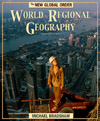 |  World Regional Geography: The New Global Order Update, 2/e Michael Bradshaw,
College of St. Mark and John
Anglo America
Chapter ObjectivesAfter reading and studying this chapter you should be able to:
| 1. Understand the label "Anglo America" and the language make up of
the region. |
 |  |  | | 2. Identify Anglo America's share of the world's GDP and how the region
compares with Western Europe and Japan. |
 |  |  | | 3. Describe the colonial period and its impacts on native Americans. |
 |  |  | | 4. Outline Anglo America's wealth of natural resources. |
 |  |  | | 5. Explain manufacturing structures and processes that helped the U.S.
achieve rapid economic growth. |
 |  |  | | 6. Differentiate Canada from the U.S. |
 |  |  | | 7. Define gentrification and describe its consequences for urban areas. |
 |  |  | | 8. Understand the growing gap between rich and poor people in the U.S. |
 |  |  | | 9. List characteristics of affluent living in the United States of America. |
 |  |  | | 10. Examine the range of natural environments within the U.S. and
Canada. |
 |  |  | | 11. List the numerous natural hazards that afflict Anglo America. |
 |  |  | | 12. Define the Megalopolis region. |
 |  |  | | 13. Compare and contrast the Midwest and the Great Plains region with
the South region. |
 |  |  | | 14. Trace the history of changing origins of immigrants to the U.S. |
 |  |  | | 15. Outline the broad historical patterns of economic development in the
U.S. |
 |  |  | | 16. Understand Canada's relationships with the U.S. |
 |  |  | | 17. List the problems facing Canada's Atlantic Provinces. |
 |  |  | | 18. Compare and contrast the provinces of Quebec and Ontario. |
 |  |  | | 19. Discuss the characteristics of American and Canadian urban areas. |
 |  |  | | 20. Identify the future prospects of the U.S. and Canada. |
|



 2002 McGraw-Hill Higher Education
2002 McGraw-Hill Higher Education